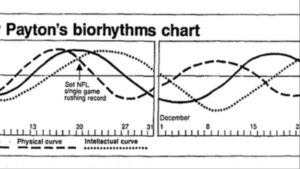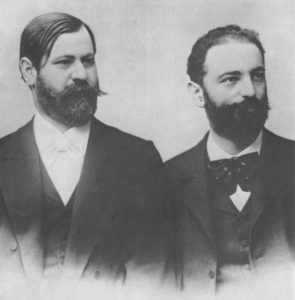
We had our share of crazes in the 70’s. We went nuts over all sorts of things. For instance, our big, gas-guzzling cars had CB radios, so we could monitor Smokie’s whereabouts. We kids had sissy bars and cheater slicks on our bikes. And our parents, and possibly we ourselves, kept an eye on our biorhythms so as to know whether each day was a good day to take risks, be creative, or perhaps to cocoon whilst nursing a triple low cycle.
Biorhythms (and I’m a better than average speller, but I’m going to vary the spelling of the term here because I couldn’t figure out how to spell THAT word at first!) were all the rage in the polyester era. An edition of Time Magazine from 1978 had its cover story devoted to the subject. It fit in perfectly with all the other pseudo-science that bloomed during that particular decade.
The man who started it all was one Wilhelm Fliess, who was a Berlin doctor and Sigmund Freud’s closest friend for more than a decade. A nose and throat specialist, he believed that the nose was responsible for many neurotic and sexual ailments, which were curable by applying cocaine to strategic areas inside the nostrils.
Reminds you of another craze partaken of by the Hollywood elite and rock stars of the 70’s, doesn’t it?

Anyhow, Fliess also theorized that three cycles governed our overall performance in living our lives: physical, emotional, and mental. The three cycles, he postulated, would be (conveniently) identical for any number of individuals born on a given day. This would create a market for arcade and handheld games circa the late 70’s to tell you exactly how you were doing, biorhythm-wise.
He impressed Freud (who planned on a death at the age of 51 based on Fliess’s predictions) and a few others, but in the 70’s, during the age of metaphysics, his ideas sparked a real craze.
Books hit the best seller list. Newspapers started publishing charts. And the aforementioned electronic devices started selling briskly.
It reached the point that cabbies in Denver were allowed days off if their biorhythms were at a triple low. An Exxon refinery in Texas would send out safety reminders to employees on the days that they were in the same foreboding predicament. Muhammad Ali’s loss to Ken Norton was pinned on the champ’s bad biorythms. And, wouldn’t you know it, when Elvis died in the throne room in 1978, he just happened to be on a triple low (as well as under the influence of a plethora of Colonel-Parker-provided-prescription drugs).
There was a lot of money to be made here, and made it was. If you wanted to check your cycles, a quarter at the video arcade would let you know. So would fifty bucks at Radio Shack for a portable unit. And if reliable, trustworthy folks like Julie Newmar, Jackie Gleason, and an executive of the Dallas Cowboys were believers, why shouldn’t the rest of us join in?
So we did. It lasted until about 1980, when it quietly submerged. But it never disappeared.